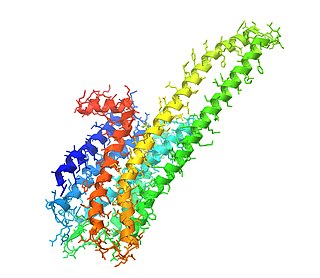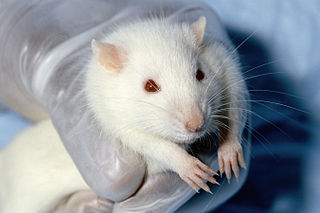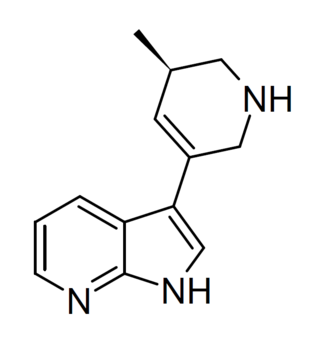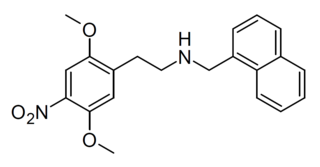
Psychedelics are a subclass of hallucinogenic drugs whose primary effect is to trigger non-ordinary mental states and a perceived "expansion of consciousness". Also referred to as classic hallucinogens or serotonergic hallucinogens, the term psychedelic is sometimes used more broadly to include various types of hallucinogens, such as those which are atypical or adjacent to psychedelia like salvia and MDMA, respectively.
Functional selectivity is the ligand-dependent selectivity for certain signal transduction pathways relative to a reference ligand at the same receptor. Functional selectivity can be present when a receptor has several possible signal transduction pathways. To which degree each pathway is activated thus depends on which ligand binds to the receptor. Functional selectivity, or biased signaling, is most extensively characterized at G protein coupled receptors (GPCRs). A number of biased agonists, such as those at muscarinic M2 receptors tested as analgesics or antiproliferative drugs, or those at opioid receptors that mediate pain, show potential at various receptor families to increase beneficial properties while reducing side effects. For example, pre-clinical studies with G protein biased agonists at the μ-opioid receptor show equivalent efficacy for treating pain with reduced risk for addictive potential and respiratory depression. Studies within the chemokine receptor system also suggest that GPCR biased agonism is physiologically relevant. For example, a beta-arrestin biased agonist of the chemokine receptor CXCR3 induced greater chemotaxis of T cells relative to a G protein biased agonist.

The 5-HT2A receptor is a subtype of the 5-HT2 receptor that belongs to the serotonin receptor family and is a G protein-coupled receptor (GPCR). The 5-HT2A receptor is a cell surface receptor, but has several intracellular locations.

A serotonin receptor agonist is an agonist of one or more serotonin receptors. They activate serotonin receptors in a manner similar to that of serotonin, a neurotransmitter and hormone and the endogenous ligand of the serotonin receptors.

25B-NBOMe is a derivative of the phenethylamine psychedelic 2C-B, discovered in 2004 by Ralf Heim at the Free University of Berlin. It acts as a potent full agonist for the 5HT2A receptor. Duration of effects lasts about 3–10 hours, although the parent compound is rapidly cleared from the blood when used in the radiolabeled form in tracer doses. Recently, Custodio et al. (2019) evaluated the potential involvement of dysregulated dopaminergic system, neuroadaptation, and brain wave changes which may contribute to the rewarding and reinforcing properties of 25B-NBOMe in rodents.

25I-NBF is a derivative of the phenethylamine hallucinogen 2C-I, which acts as a highly potent partial agonist for the human 5-HT2A receptor, with bias towards the β-arrestin 2 coupled signalling pathway. It has been studied in its 11C radiolabelled form as a potential ligand for mapping the distribution of 5-HT2A receptors in the brain, using positron emission tomography (PET).

25C-NBOMe is a psychedelic drug and derivative of the psychedelic phenethylamine 2C-C. 25C-NBOMe appeared on online vendor sites in 2010 but was not reported in the literature until 2011. It acts as a potent agonist of the 5-HT2A receptor, and has been studied in its 11C radiolabelled form as a potential ligand for mapping the distribution of 5-HT2A receptors in the brain, using positron emission tomography (PET). Multiple deaths have occurred from usage of 25C-NBOMe due to the ease of accidental overdose. The long-term toxic effects of the drug have not been researched.

The head-twitch response (HTR), also sometimes known as wet dog shakes (WDS) in rats, is a rapid side-to-side head movement that occurs in mice and rats when the serotonin 5-HT2A receptor is activated. Serotonergic psychedelics, including lysergic acid diethylamide (LSD), induce the HTR, and so the HTR is widely used as an animal behavioral model of hallucinogen effects and to discover new psychedelic drugs. HTR-like effects are also induced by psychedelics in other animal species, for instance cats and stump-tailed macaque monkeys. Other related behaviors to head twitches induced by serotonergic agents include limb jerks and body scratches. The only other behavioral paradigms for assessment of psychedelic-like effects in animals are drug discrimination (DD), prepulse inhibition (PPI), and time perception.

25D-NBOMe is a derivative of the phenethylamine derived hallucinogen 2C-D. It acts in a similar manner to related compounds such as 25I-NBOMe, which is a potent agonist at the 5-HT2A receptor. 25D-NBOMe has been sold as a street drug since 2010 and produces similar effects in humans to related compounds such as 25I-NBOMe and 25C-NBOMe. It was banned as a Temporary Class Drug in the UK on 10 June 2013 after concerns about its recreational use.

25N-NBOMe is a derivative of the hallucinogen 2C-N. The pharmacological properties of 25N-NBOMe have not been described in the scientific literature, but it is believed to act in a similar manner to related compounds such as 25I-NBOMe and 25C-NBOMe, which are potent agonists at the 5HT2A receptor. 25N-NBOMe has been sold as a street drug and has only been described in the literature in terms of identification by forensic analysis.

25E-NBOMe is a derivative of the phenethylamine 2C-E. It acts in a similar manner to related compounds such as 25I-NBOMe, which are potent agonists at the 5-HT2A receptor. 25E-NBOMe has been sold as a drug and produces similar effects in humans to related compounds such as 25I-NBOMe and 25C-NBOMe.

25H-NBOMe (NBOMe-2C-H) is a derivative of the phenethylamine hallucinogen 2C-H, which acts as a highly potent full agonist for the human 5-HT2A receptor.

25iP-NBOMe is a derivative of the phenethylamine hallucinogen 2C-iP, which acts as a highly potent agonist for the human 5-HT2A receptor.

The 25-NB (25x-NBx) series, or NBOMe series, also known as the N-benzylphenethylamines, is a family of serotonergic psychedelics. They are substituted phenethylamines and were derived from the 2C family. The most commonly encountered NBOMe drugs are 25I-NBOMe, 25B-NBOMe, and 25C-NBOMe.

(R)-69 (3IQ) is a tetrahydropyridine derivative which acts as a 5-HT2A receptor agonist, with 4.6-fold selectivity over 5-HT2B and 49-fold selectivity over 5-HT2C. It has a 5-HT2A Ki of 680 nM and an EC50 of 41 nM. (R)-69 is a biased agonist selective for activation of the Gq coupled signalling pathway, with much weaker activation of the β-arrestin 2 coupled pathway. In animal studies it produces antidepressant-like activity but without producing the head-twitch response associated with psychedelic effects.

25O-NBcP (NBcPr-2C-O) is a phenethylamine derivative from the 25-NB class. It acts as a potent agonist at the 5-HT2A receptor with weaker activity at 5-HT2B and 5-HT2C, and unlike the parent compound 2C-O, 25O-NBcP produces a head-twitch response in animal studies which often correlates with potential for psychedelic effects in humans.

2C2-NBOMe (NBOMe-MMDPEA-2) is a phenethylamine derivative from the 25-NB class. It acts as a potent agonist at the 5-HT2A receptor with weaker activity at 5-HT2B and 5-HT2C, and produces a head-twitch response in animal studies which often correlates with potential for psychedelic effects in humans. It is related in structure to psychedelic amphetamine derivatives such as MMDA-2 and is the first phenethylamine derivative with a methylenedioxy substitution on the phenyl ring but no alkyl substitution on the alpha carbon, that has been shown to produce psychedelic-appropriate responding in animals.

25N-N1-Nap is a phenethylamine derivative from the 25-NB class, which acts as a potent agonist at the 5-HT2A receptor with weaker activity at 5-HT2B and 5-HT2C. 25N-N1-Nap is a biased agonist, producing robust activation of 5-HT2A coupled signalling pathways mediated by beta arrestin 2, but with little or no activation of pathways mediated via Gq. In animal studies it produces antipsychotic effects but without producing the head-twitch response associated with psychedelic activity.
ITI-1549 is a putatively non-hallucinogenic serotonin 5-HT2A receptor agonist which is under development for the treatment of mood disorders and other psychiatric disorders. In addition to acting at the serotonin 5-HT2A receptor, it is also an antagonist of the serotonin 5-HT2B receptor and an agonist of the serotonin 5-HT2C receptor. The drug's route of administration has not been specified.

6-MeO-DMT, or 6-methoxy-N,N-dimethyltryptamine, also known as 6-OMe-DMT, is a serotonergic drug of the tryptamine family. It is the 6-methoxy derivative of the serotonergic psychedelic N,N-dimethyltryptamine (DMT) and is a positional isomer of the serotonergic psychedelic 5-MeO-DMT.


















